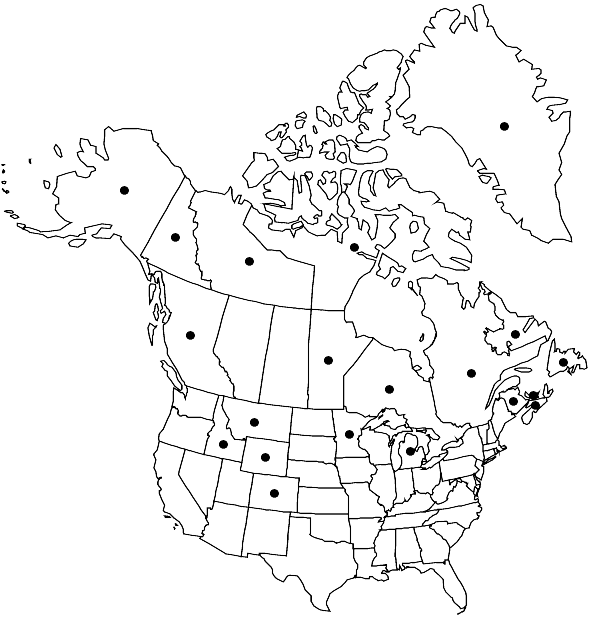Difference between revisions of "Cynodontium polycarpon"
Coroll. Bryol. Eur., 12. 1856,.
FNA>Volume Importer |
imported>Volume Importer |
||
| (6 intermediate revisions by 2 users not shown) | |||
| Line 6: | Line 6: | ||
|place=12. 1856, | |place=12. 1856, | ||
}} | }} | ||
| − | |basionyms={{Treatment/ID/ | + | |basionyms={{Treatment/ID/Basionym |
|name=Fissidens polycarpos | |name=Fissidens polycarpos | ||
|authority=Hedwig | |authority=Hedwig | ||
| + | |rank=species | ||
| + | |publication_title=Sp. Musc. Frond., | ||
| + | |publication_place=159. 1801 | ||
}} | }} | ||
|synonyms= | |synonyms= | ||
| Line 25: | Line 28: | ||
|elevation=moderate to high elevations | |elevation=moderate to high elevations | ||
|distribution=Greenland;B.C.;Man.;N.B.;Nfld. and Labr.;N.W.T.;N.S.;Nunavut;Ont.;P.E.I.;Que.;Yukon;Alaska;Colo.;Idaho;Mich.;Minn.;Mont.;Wyo.;n Eurasia;Atlantic Islands (Iceland). | |distribution=Greenland;B.C.;Man.;N.B.;Nfld. and Labr.;N.W.T.;N.S.;Nunavut;Ont.;P.E.I.;Que.;Yukon;Alaska;Colo.;Idaho;Mich.;Minn.;Mont.;Wyo.;n Eurasia;Atlantic Islands (Iceland). | ||
| − | |discussion=<p>Specimens of Cynodontium polycarpon generally found in American herbaria upon re-examination will likely be C. jenneri instead. The latter was once considered to be a variety of C. polycarpon, accounting for many distributional records of C. polycarpon in North America; for example, in the most recent Canadian checklist (R. R. Ireland et al. 1987), of 10 provincial reports only that for the Northwest Territories could be verified by the authors, and the remaining Canadian distribution cited above must be viewed, then, with skepticism. E. Nyholm (1986+, fasc. 1) stated that both C. polycarpon and C. strumiferum have somewhat smaller, less regularly quadrate cells in the distal portion of the leaf and a broadly recurved margin on at least one side of the leaf as opposed to the case of C. jenneri, which has rather regularly quadrate, transparent cells. According to Nyholm, laminal cells of C. polycarpon are 10–12(–14) µm wide, whereas those of C. jenneri are larger: 12–14(–20) µm. H. A. Crum and L. E. Anderson (1981) considered this species doubtfully present in North America. Cynodontium polycarpon subsp. fallax (Limpricht) Kindberg was excluded by Anderson et al. (1990).</p> | + | |discussion=<p>Specimens of <i>Cynodontium polycarpon</i> generally found in American herbaria upon re-examination will likely be <i>C. jenneri</i> instead. The latter was once considered to be a variety of <i>C. polycarpon</i>, accounting for many distributional records of <i>C. polycarpon</i> in North America; for example, in the most recent Canadian checklist (R. R. Ireland et al. 1987), of 10 provincial reports only that for the Northwest Territories could be verified by the authors, and the remaining Canadian distribution cited above must be viewed, then, with skepticism. E. Nyholm (1986+, fasc. 1) stated that both <i>C. polycarpon</i> and <i>C. strumiferum</i> have somewhat smaller, less regularly quadrate cells in the distal portion of the leaf and a broadly recurved margin on at least one side of the leaf as opposed to the case of <i>C. jenneri</i>, which has rather regularly quadrate, transparent cells. According to Nyholm, laminal cells of <i>C. polycarpon</i> are 10–12(–14) µm wide, whereas those of <i>C. jenneri</i> are larger: 12–14(–20) µm. H. A. Crum and L. E. Anderson (1981) considered this species doubtfully present in North America. <i>Cynodontium polycarpon</i> <i></i>subsp.<i> fallax</i> (Limpricht) Kindberg was excluded by Anderson et al. (1990).</p> |
|tables= | |tables= | ||
|references= | |references= | ||
| Line 34: | Line 37: | ||
-->{{#Taxon: | -->{{#Taxon: | ||
name=Cynodontium polycarpon | name=Cynodontium polycarpon | ||
| − | |||
|authority=(Hedwig) Schimper | |authority=(Hedwig) Schimper | ||
|rank=species | |rank=species | ||
| Line 44: | Line 46: | ||
|habitat=Acid rock | |habitat=Acid rock | ||
|illustrator=Barbara Alongi | |illustrator=Barbara Alongi | ||
| + | |illustration copyright=Flora of North America Association | ||
|elevation=moderate to high elevations | |elevation=moderate to high elevations | ||
|distribution=Greenland;B.C.;Man.;N.B.;Nfld. and Labr.;N.W.T.;N.S.;Nunavut;Ont.;P.E.I.;Que.;Yukon;Alaska;Colo.;Idaho;Mich.;Minn.;Mont.;Wyo.;n Eurasia;Atlantic Islands (Iceland). | |distribution=Greenland;B.C.;Man.;N.B.;Nfld. and Labr.;N.W.T.;N.S.;Nunavut;Ont.;P.E.I.;Que.;Yukon;Alaska;Colo.;Idaho;Mich.;Minn.;Mont.;Wyo.;n Eurasia;Atlantic Islands (Iceland). | ||
| Line 50: | Line 53: | ||
|publication year= | |publication year= | ||
|special status= | |special status= | ||
| − | |source xml=https:// | + | |source xml=https://bitbucket.org/aafc-mbb/fna-data-curation/src/2e0870ddd59836b60bcf96646a41e87ea5a5943a/coarse_grained_fna_xml/V27/V27_542.xml |
|genus=Cynodontium | |genus=Cynodontium | ||
|species=Cynodontium polycarpon | |species=Cynodontium polycarpon | ||
Latest revision as of 21:26, 5 November 2020
Stems to 5 cm. Leaves to 5 mm, rather broadly lanceolate, long-acuminate; distal leaf margin broadly recurved, at least on one side, 2-stratose; cells of lamina smooth, scattered mammillose or distinctly mammillose distally, mammillae well developed especially on the adaxial side, distal cells 10 µm wide or more. Perigonium sessile. Seta ca. 0.8 cm, straight wet or dry. Capsule symmetrical, erect, not strumose; annulus of large, deciduous cells.
Phenology: Capsules mature summer.
Habitat: Acid rock
Elevation: moderate to high elevations
Distribution

Greenland, B.C., Man., N.B., Nfld. and Labr., N.W.T., N.S., Nunavut, Ont., P.E.I., Que., Yukon, Alaska, Colo., Idaho, Mich., Minn., Mont., Wyo., n Eurasia, Atlantic Islands (Iceland).
Discussion
Specimens of Cynodontium polycarpon generally found in American herbaria upon re-examination will likely be C. jenneri instead. The latter was once considered to be a variety of C. polycarpon, accounting for many distributional records of C. polycarpon in North America; for example, in the most recent Canadian checklist (R. R. Ireland et al. 1987), of 10 provincial reports only that for the Northwest Territories could be verified by the authors, and the remaining Canadian distribution cited above must be viewed, then, with skepticism. E. Nyholm (1986+, fasc. 1) stated that both C. polycarpon and C. strumiferum have somewhat smaller, less regularly quadrate cells in the distal portion of the leaf and a broadly recurved margin on at least one side of the leaf as opposed to the case of C. jenneri, which has rather regularly quadrate, transparent cells. According to Nyholm, laminal cells of C. polycarpon are 10–12(–14) µm wide, whereas those of C. jenneri are larger: 12–14(–20) µm. H. A. Crum and L. E. Anderson (1981) considered this species doubtfully present in North America. Cynodontium polycarpon subsp. fallax (Limpricht) Kindberg was excluded by Anderson et al. (1990).
Selected References
None.